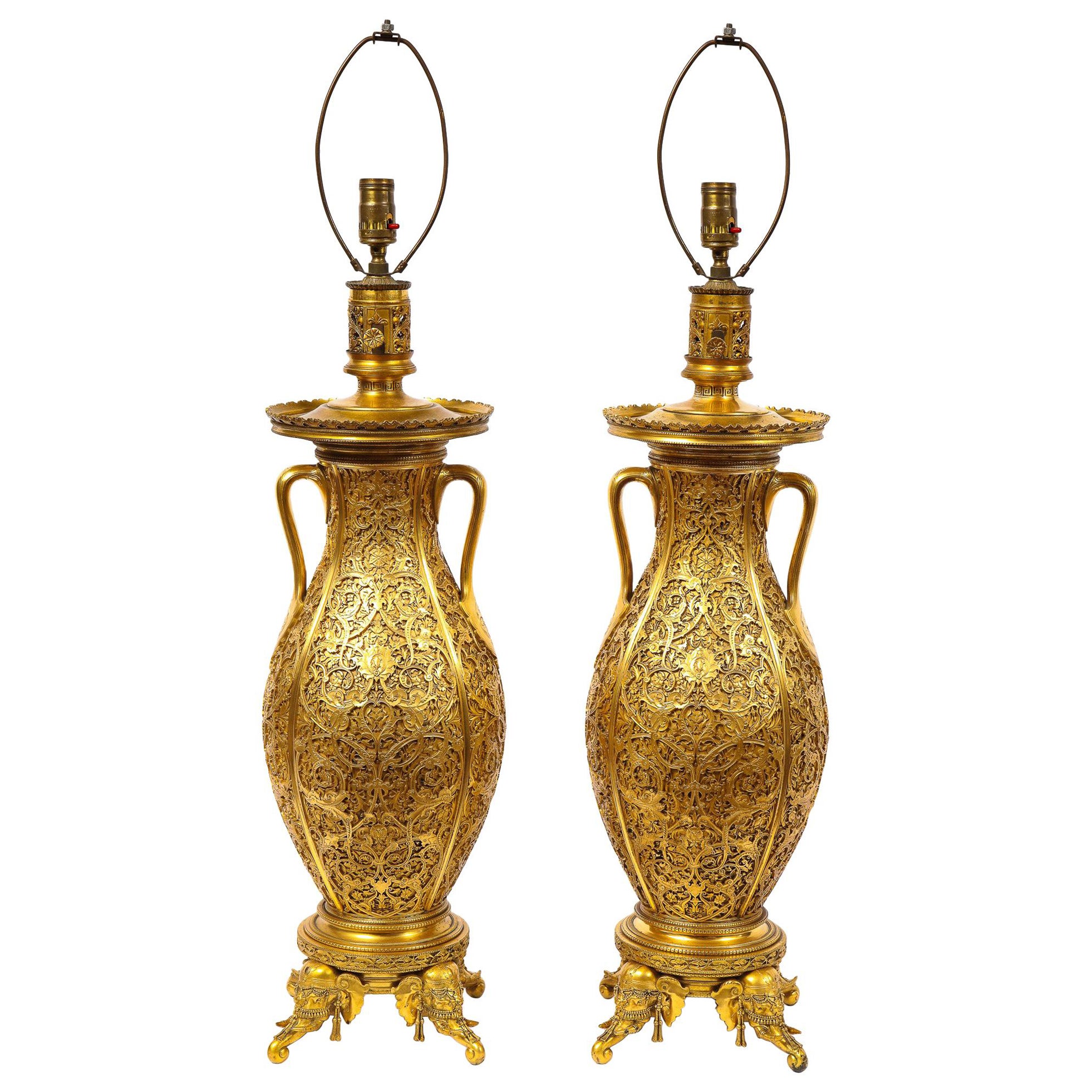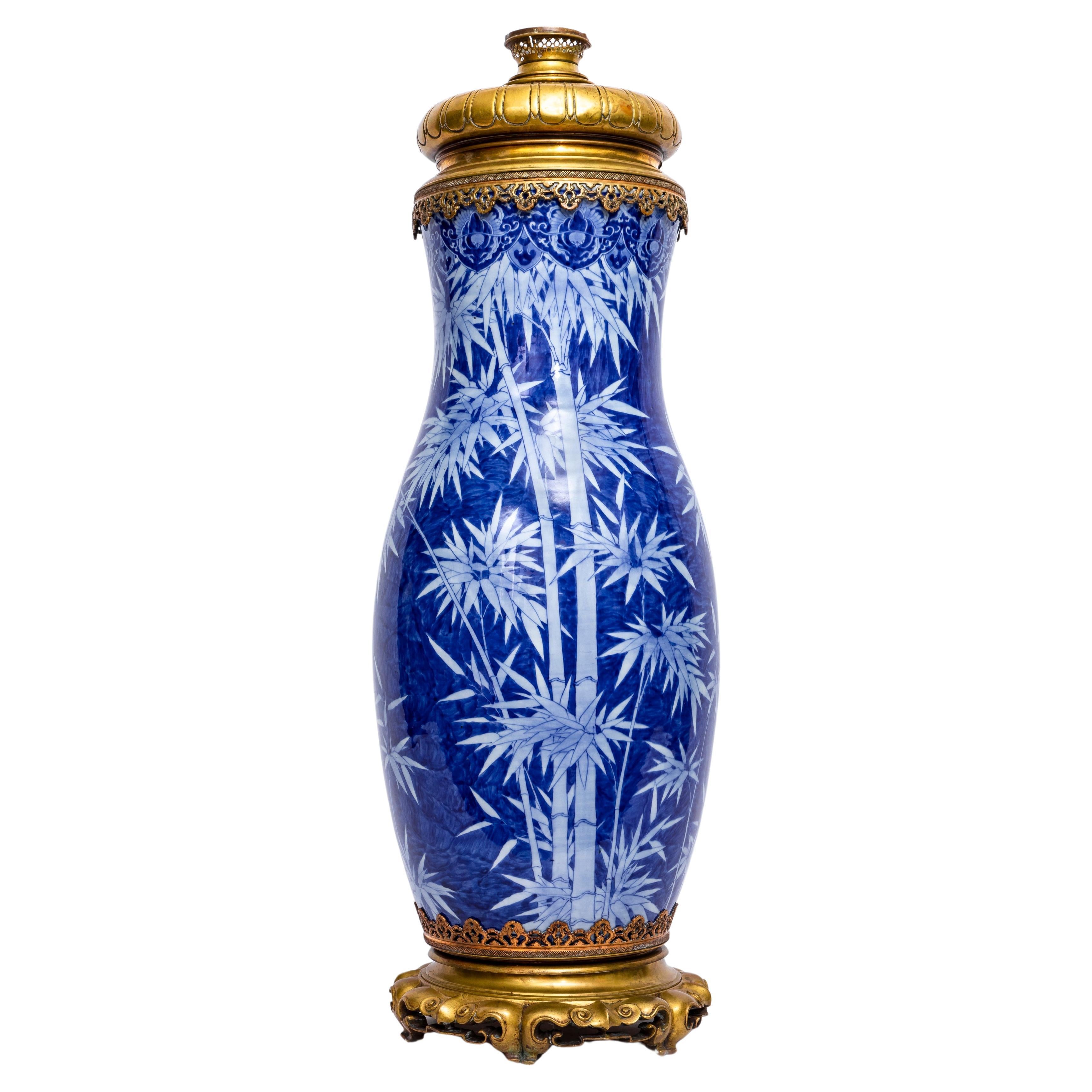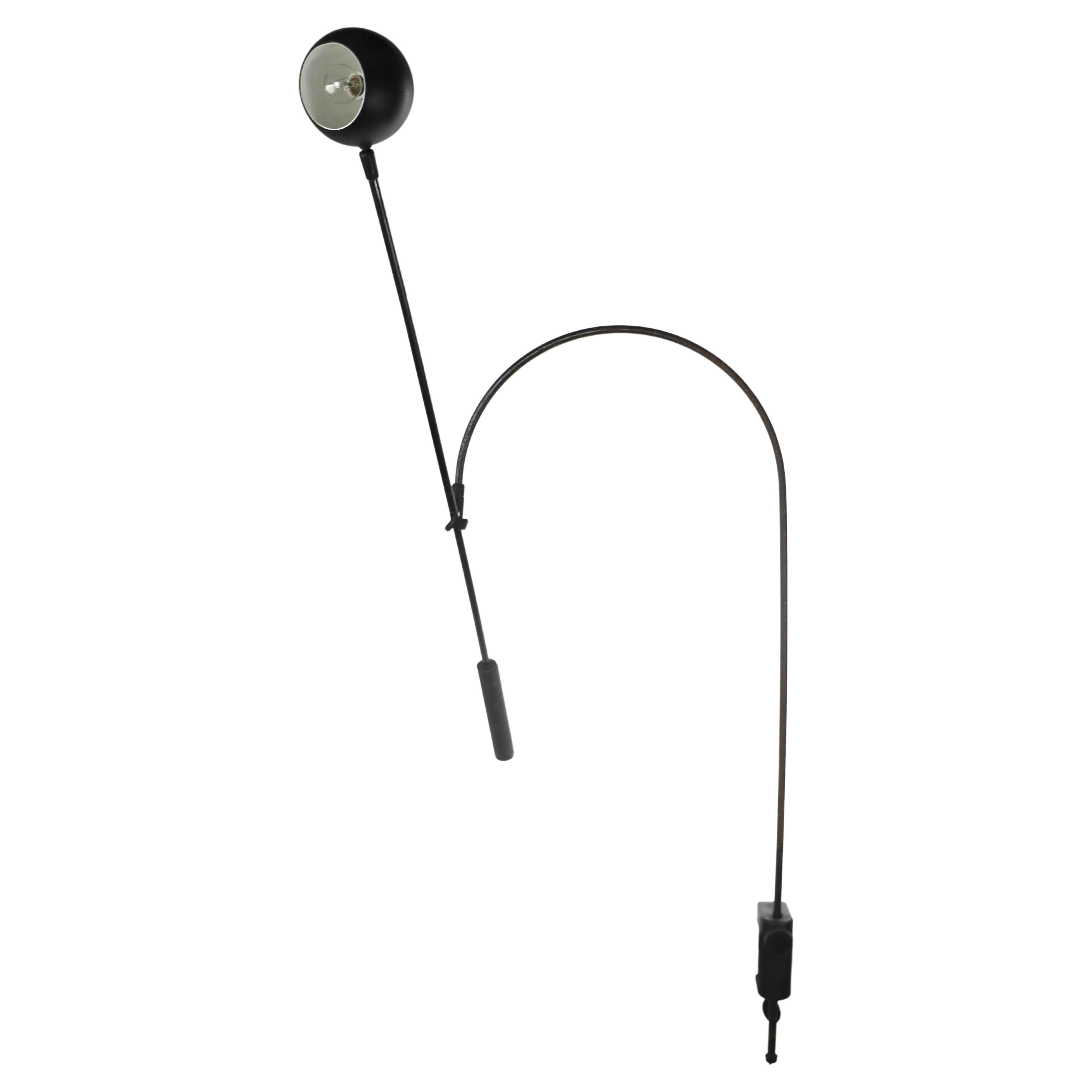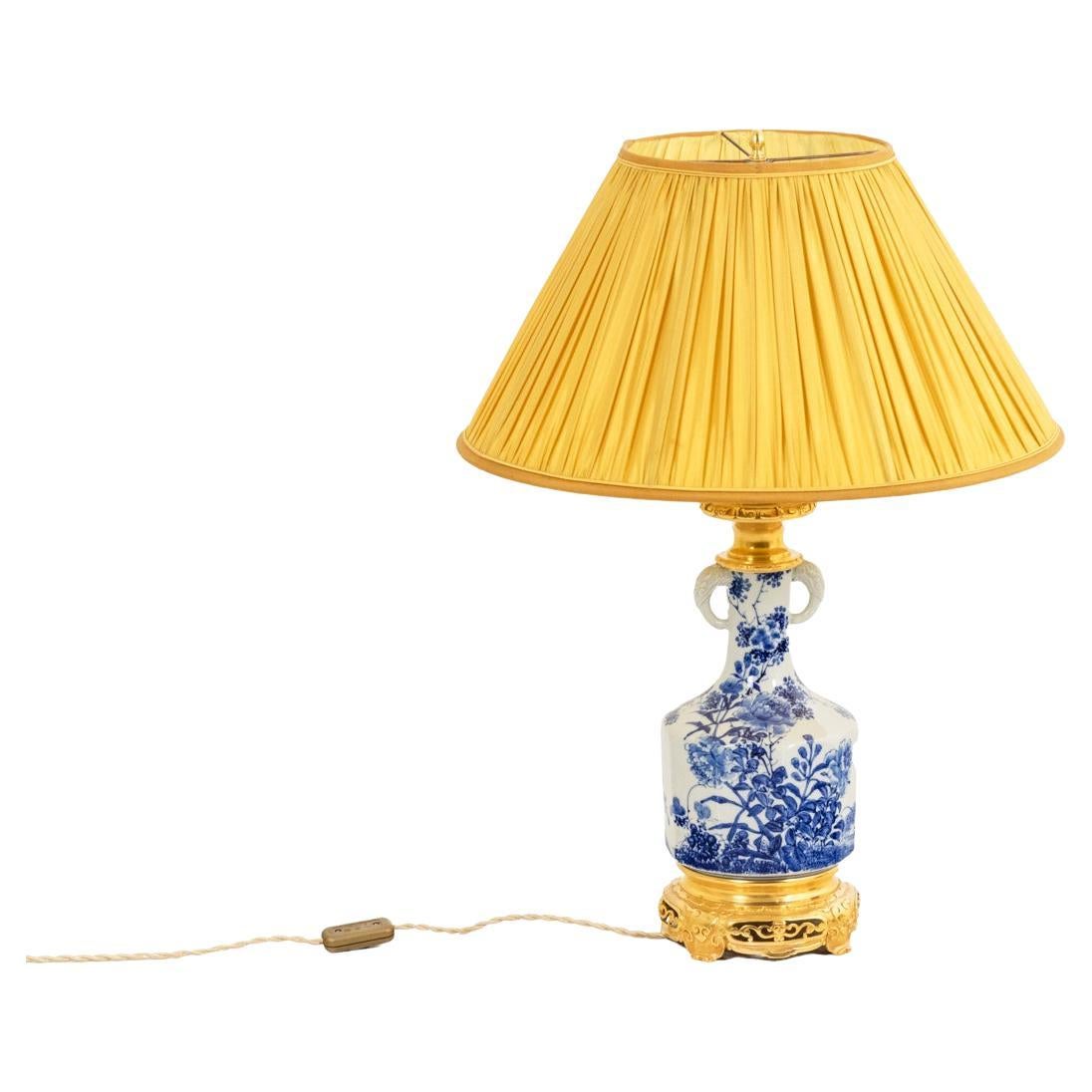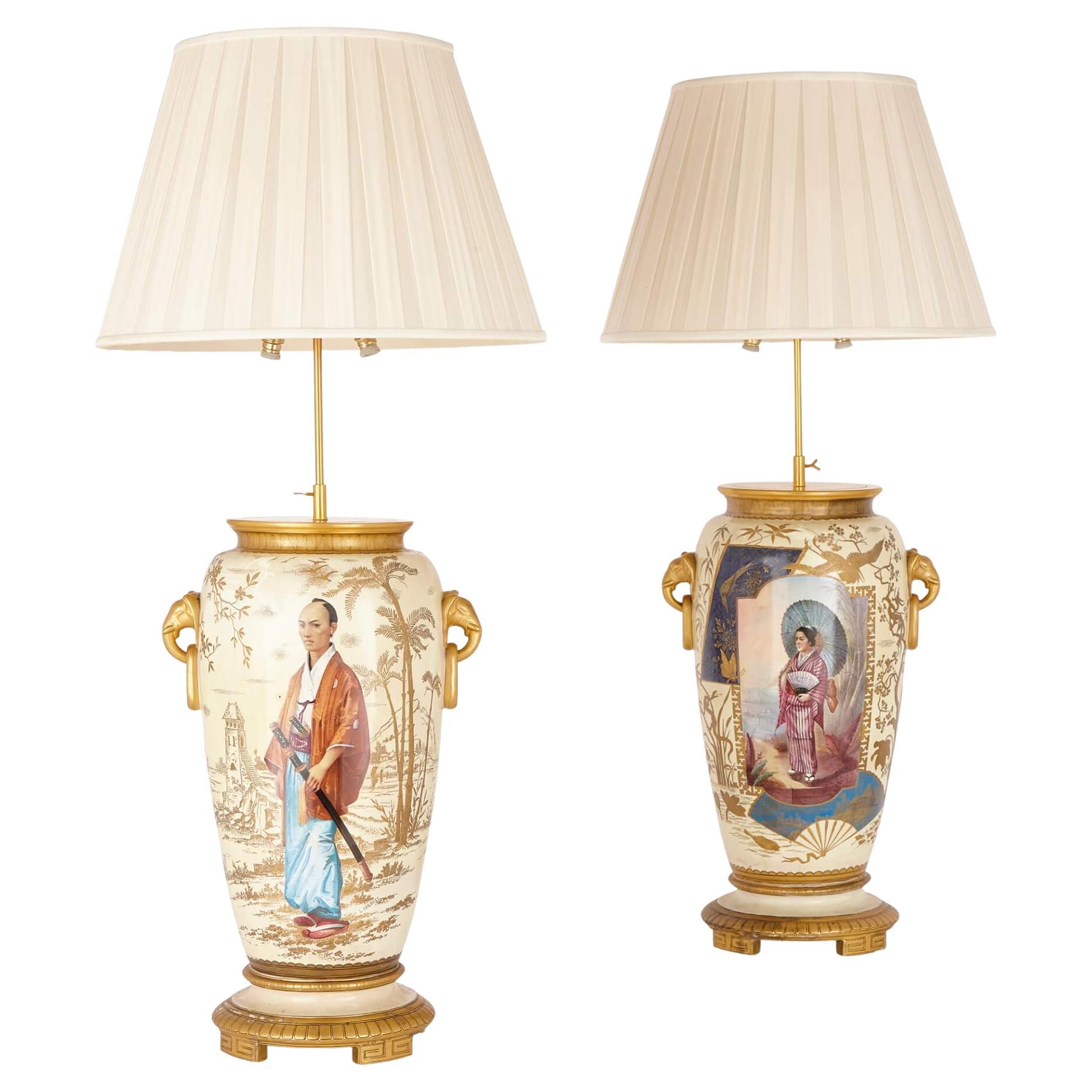Items Similar to Japonisme Lamp Att. to E. Lièvre , Japan-France, Circa 1880
Want more images or videos?
Request additional images or videos from the seller
1 of 10
Japonisme Lamp Att. to E. Lièvre , Japan-France, Circa 1880
About the Item
Height with lampshade : 133 cm (52,3 in.) / without lampshade : 125 cm (49,2 in.) ;
Lampshade - Height 74 cm (29,1 in.) ; Diameter : 86 cm (33,8 in.)
Important Japanese style gourd-shaped lamp, made with a polychrome Kutani porcelain vase decorated with lake scene and flowers in cartouches, in the middle of flying waders on a red background. It is covered with its original beige pleated silk lampshade, embroided with flowers and waders. It rests on an « old gold » patinated bronze base with stylized openwork decoration, topped with a Fô dog on each foot.
Related work : Japanese enamel porcelain vase in a Japanese style mount by Edouard Lièvre, circa 1875 (Reproduced in Connaissance des arts Edouard Lièvre, H.S. n°228, p.8) see attached.
Edouard Lièvre (1829-1886) studied under the painter Thomas Couture (1815-1879), one of the more conspicuous artists in the circle of the Empress Eugenie. E. Lièvre soon devoted himself, however, to the art of furniture design. A talented ornamentalist, marked by the eclecticism typical of the Second Empire, Lièvre knew how to avail himself of skillful collaborators in order to create pieces in various styles: Renaissance, Louis 16th or Oriental, which last were part of the great artistic movement in fashion since the 1860’s: the Japanese style named also Aesthetic Movement. they recreated an imaginary Far East adapted to decorate Western reception rooms. As an Interior decorator Lièvre also matched his luxurious and refined furniture with bronzes, ceramics and even fabrics. This Oriental exoticism, which only the richest could afford, appealed to bankers, judges, artists and famous courtesans as well as the Royal and Princely families. After the death of Edouard Lièvre, the greater part of his models, sketches and cabinet designs were bought by art publishers such as « l’Escalier de Cristal » thus giving them the right to reproduce Lièvre’s furniture with their own stamp (see « Ventes de la succession Lièvre », Hotel Drouot, 27 fevrier 1890).
- Attributed to:Ferdinand Barbedienne (Maker)Edouard Lievre (Designer)
- Dimensions:Height: 52.37 in (133 cm)Diameter: 33.86 in (86 cm)
- Style:Japonisme (In the Style Of)
- Materials and Techniques:
- Place of Origin:
- Period:
- Date of Manufacture:circa 1880
- Condition:Wear consistent with age and use. The vintage lampshade has some wear.
- Seller Location:PARIS, FR
- Reference Number:
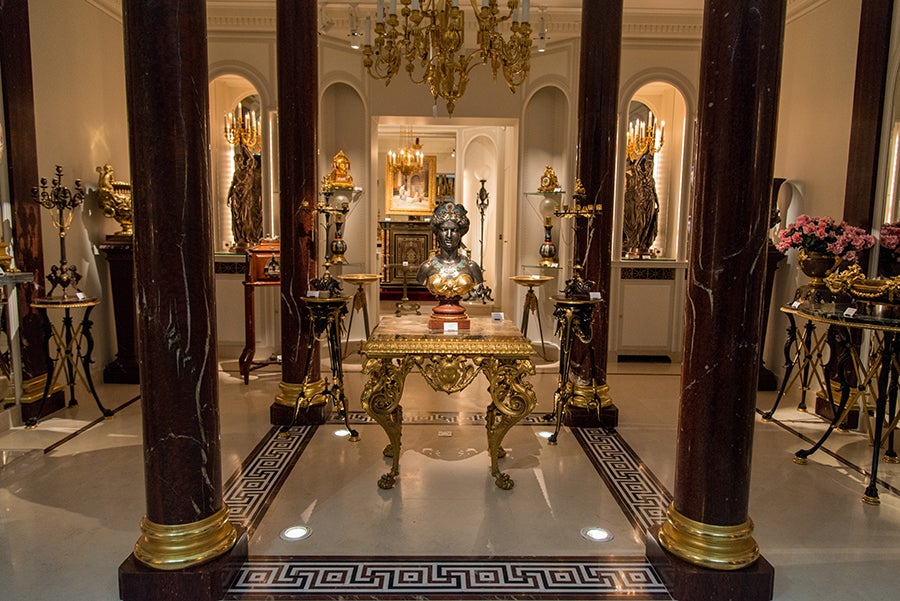
About the Seller
4.9
Vetted Seller
These experienced sellers undergo a comprehensive evaluation by our team of in-house experts.
Established in 1997
1stDibs seller since 2018
74 sales on 1stDibs
Typical response time: <1 hour
Associations
International Confederation of Art and Antique Dealers' Associations
- ShippingRetrieving quote...Ships From: Saint Ouen, France
- Return PolicyA return for this item may be initiated within 7 days of delivery.
More From This SellerView All
- "Japonisme" Cylinder Desk Att. to G. Viardot, France, circa 1880By Gabriel ViardotLocated in PARIS, FRRare Japanese style cylinder desk in tinted and carved wood, richly engraved on all sides with foliage, cherry branches and geometric interlacing. Surmounted by two asymmetrical shelves, the cylinder is decorated with an engraved dragon. Opening this cylinder reveals many compartments with adjustable dimensions, a drawer with engraved decoration and letter storage. The cylinder sides can open laterally, allowing a larger area for working and writing. The lower part of the desk is formed on the left by five superimposed drawers decorated with geometric interlacing and carved branches, as well as Japanese characters, deer and mother-of-pearl foliage. On the right, there is a drawer and a door decorated with carved leaves and mother-of-pearl interlacing, revealing four drawers forming compartments. An ingenious mechanism makes it possible, when the cylinder is closed with a key, to completely lock the desk. Gabriel Viardot career began as a wood carver and he produced small furniture, sculpturally carved with naturalistic motifs and animals. In the 1855 Exposition Universelle in Paris, his finely sculpted objects were well received. However, with the increasing importation of similarly produced Swiss and German articles, he found less opportunity for these and decided to innovate. G. Viardot succeeded to his father’s business in 1861 installed rue Rambuteau in Paris. Around 1870 he turned to the idea of producing « Meubles genre Chinois et Japonais ». The taste in Europe for exotic furniture, incorporating sometimes authentic Chinese or Japanese objects...Category
Antique 1880s French Japonisme Desks
MaterialsMother-of-Pearl, Wood
- "Japonisme" Vitrine Attributed to A. Giroux, France, Circa 1880By Maison GirouxLocated in PARIS, FRRare aesthetic movement showcase, opening in its upper part by two beveled glass doors framed by brass moldings, in its lower part by two door panels in carved walnut decorated with blooming branches and gilded bronze ornaments representing dragons and birds. The sides are carved, like wicker woven. This showcase is topped by an important carved and gilded walnut cornice depicting a Fô Dog in its center, with a protective power, and rests on elephant head with overtuned trunk shaped feet. This type of elephant head with overtuned trunk shaped feet is a characteristic of the Maison Giroux, which can be found on many objects they produced. Aesthetic movement cabinet, signed Maison Alphonse Giroux...Category
Antique 1880s French Japonisme Vitrines
MaterialsBronze
- Japanese Style Cabinet-Secretary Att. to Perret & Vibert, France, circa 1880By Perret et VibertLocated in PARIS, FRA Japanese style carved wood cabinet, with a painted decor imitating Japanese lacquer, ornamented with flowers, birds and butterflies. Opening onto two drawers and a paper filer, the upright-secretary door is also fitted with red velvet. Surmounted by a drawer and asymmetrical shelves, composed in the Japanese « zen » spirit, the cabinet stands on four legs joined by an engraved stretcher. The great influence of the Far-East, through China and Japan, in the second half of the 19th century French art could be found first in painting and soon after in decorative arts and furniture as well. Following the Franco-English military campaign led in 1860 against the Imperial army in China, the French troops of Napoleon III brought back from the Summer Palace, a part of the Chinese Imperial court treasure, which will make up the famous Chinese Museum of Empress Eugénie at the Fontainebleau Palace. The French artists won’t be long to take inspiration from those exotic and sumptuous objects for their creations, as they used to do in the 18th century, when the best French cabinet-makers adapted the Chinese lacquers on the luxurious royal chests. But the influence of Japan, at the Meiji period (1868-1912), came also very quickly to France, thanks to the opening of the country in the middle of the 19th century, as well as the development of traveling and the amazing Universal Exhibitions, in which Japan participated for the first time in 1867 in Paris. Then many Japanese objects and prints were imported to France and to all Europe, and for which some collectors spent already fortunes. With Manet and Impressionists generation, the passion for Japanese art, more than a simple taste for an exotic style, was still in fashion until the turn of the 19th century. It provoked not only a craze among the French aristocratic families as well as the wealthy Paris high society, wishing renew their mansion inner decoration, but turned also to a real revolutionary movement among the “avant-garde” artists. Those artists, whoever they were, painters, cabinet-makers or designers of ceramic, bronze and crystal objects, adapted then those techniques and naturalistic motifs unknown until this time. Christofle, very famous since 1867 as a silversmith, was also one of the leaders among the inventors of Japanism. He knew how to use Japanese elements to his own splendid works made in silver or “cloisonné” enameled bronze. During the 1878 Paris Universal Exhibition, Christofle presented with great success his life-sized bronze Japanese ladies torcheres, executed by the renowned sculptor Guillemin. Another famous company to be mentioned, is “L’Escalier de Cristal”, producing art objects and furniture, all of high standard quality and innovating much with their Japanese decor. Highly remarked during the Universal Exhibitions, “L’Escalier de Cristal” collaborated with the greatest artists, such Gallé and Rousseau for glass- and ceramic wares, and the cabinet-makers Lièvre and Viardot, whom made furniture including sometimes authentic Japanese elements. In 1872, Alfred Perret and Ernest Vibert opened in Paris, at 33 rue du Quatre-Septembre a store that offered “natural bamboo furniture and cane seats” and all kinds of textile fittings for furniture. This furniture used for winter gardens and terraces of mansions knew then a resounding success. They developed their business around 1884 with their Japanese style furniture, very close to that executed by Gabriel Viardot (1830-1906). In 1886, the company appearing in the category of “Chinoiserie and Japoneries” offered, in addition to furniture and seating creation, works of art and inlaid furniture directly imported from the Far East ; an activity that expanded rapidly. Their exotic fantasy furniture presented at the Universal Exhibition of Paris in 1889 and 1900, rewarded them two silver medals. In 1894, the company was listed under the name “Perret et Vibert”, headed by the son of Alfred Perret and Ernest Vibert. The same year, they redesigned their store on rue du Quatre-Septembre, creating ten new show-rooms, showing complete furniture sets of Japanese and Chinese style inspiration. It was not until 1895, that the company was finally named “La Maison des Bambous” and organized then in their shops an “exhibition of country furniture and seats for castles and villas”, which was visited by Empress Eugenie to furnish her villa Cyrnos at Cap Martin. She actually was a regular customer of the “Maison des Bambous” as she bought repeatedly furniture. In October of the same year, the king of Greece...Category
Antique 1880s French Japonisme Secretaires
MaterialsWood
- Japanese Style Planter Attributed to l'Escalier de Cristal, France, circa 1880By L'Escalier de Cristal, Edouard LievreLocated in PARIS, FRLarge planter decorated on the belly with a rotating decoration of polychrome flowers and geometric patterns in cloisonné enamel on a red background. It is inserted in an important p...Category
Antique 1880s French Japonisme Planters, Cachepots and Jardinières
MaterialsEnamel, Bronze
- Neo-Renaissance Cabinet by P. Sormani and attr. to E. Lièvre, France, Circa 1870By Paul Sormani, Edouard LievreLocated in PARIS, FRSigned twice on the lock P. SORMANI 10 rue Charlot Paris Rare neo-Renaissance cabinet in carved wood and Portor marble, adorned with chiseled and gilded bronze. The upper, part, surmounted by a frieze of posts and marble cabochons, consists of a central door decorated with a carved panel representing the birth of Venus, framed by two pairs of ringed and fluted columns with Corinthians capitals in gilded bronze revealing two doors with secret opening. Two drawers with lion’s head shaped handles and a central drawer decorated with tracery in gilded bronze complete the upper part of this cabinet. In the lower part, two drawers on the belt with diamond...Category
Antique 1870s French Renaissance Cabinets
MaterialsMarble, Bronze
- Onyx and Bronze Neo-Greek Gueridon Att. to Barbedienne and Sevin, France, c.1880By Ferdinand Barbedienne, Louis-Constant SevinLocated in PARIS, FRGueridon made in silvered and gilded bronze, composed of four claw feet decorated with lion’s head held together by crossed bars in gilded bronze. It is surmounted by a large onyx to...Category
Antique 1880s French Greek Revival Gueridon
MaterialsOnyx, Bronze
You May Also Like
- Pair of French Japonisme Ormolu Vases E. Lièvre, Executed by F. BarbedienneBy Ferdinand Barbedienne, Edouard LievreLocated in New York, NYAn important and monumental pair of very fine 19th century French Japonisme/Orientalist ormolu vases designed by Edouard Lièvre and Executed by Ferdinand Barbedienne. Each body with an oval shape, finely sculpted in a floral design, fringed by orientalist style handles with cartouches, the neck surmounted by a circular pierced scrolling dragon frieze. Each vase resting on a group of four orientalist style jeweled elephant...Category
Antique 1870s French Japonisme Vases
MaterialsBronze
- White Porcelain Lamp by Pillivuyt, Japonisme, France, circa 1970By Charles Pillivuyt & CieLocated in VÉZELAY, FRBeautiful white porcelain living room lamp. Far Eastern inspiration / Japonism, France, circa 1970-1980. Stamped "Pillivuyt France Porcelain since 1818" "E 86 3" "34" In very good...Category
Vintage 1970s French Japonisme Table Lamps
MaterialsPorcelain
- A Large French Ormolu Mounted Japanese Blue & White Porcelain Vase/LampBy Edouard LievreLocated in New York, NYAn Incredible and Quite Large 19th Century French Ormolu Mounted Japanese Blue and White Porcelain Vase Turned to Lamp, The moun...Category
Antique 19th Century French Japonisme Table Lamps
MaterialsBronze
- Clamp on Orbiter Lamp Att. to KovacsBy Kovacs, George KovacsLocated in New York, NYRare clamp on orbiter desk, task lamp in the postmodern school, attributed to George Kovacs. The lamp features an arched vertical support that attaches to the...Category
Mid-20th Century American Mid-Century Modern Table Lamps
MaterialsSteel
- Lamp in Japanese Porcelain and Gilt Bronze, circa 1880Located in Saint-Ouen, FRBaluster-shaped Japanese porcelain lamp with floral decoration, in blue tones. Gilt bronze mount. Quadripod base, top of the frame adorned with gilt rhinestones. Work realized cir...Category
Antique Late 19th Century Table Lamps
MaterialsBronze
- Pair of French Antique Japonisme Glazed Ceramic and Ormolu Mounted LampsBy L. MalpassLocated in London, GBPair of French antique Japonisme glazed ceramic and ormolu mounted lamps French, Late 19th Century Lamps: height 104cm, width 36cm, depth 26cm Shades: height 33cm, diameter 50cm In the Japonisme style, these superb, exceptionally large lamps (converted from vases) are made from glazed ceramics and fitted with ormolu mounts. The beautiful vases are parcel gilt and decorated with exquisite images of, to the front, a Japanese male figure on one and a female figure on the other; complemented by images of Japanese landscapes including trees, birds (ducks), shrubbery, flowers, and insects, including stick insects and butterflies. Each piece is fitted with superb ormolu elephant...Category
Antique Late 19th Century French Japonisme Table Lamps
MaterialsOrmolu
Recently Viewed
View AllMore Ways To Browse
Refined Furniture
French Eclectic
1880 Fabric
Made To Order Table Lamps
French Living Rooms
1880 French Lamp
Old Antique Lamp
Old Antique Lamps
Japanese Style Table
Old Lamp Antique Furniture
Old Lamps Antique Furniture
Antique Lighting Part
Aesthetic Movement Japanese
Table Lamp To Match
Used Hotel Lamps
Japanese Antique Lamp
Japanese Antique Lamps
Antique Japanese Lamp
